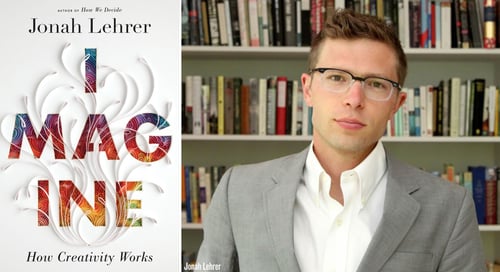BOOK REVIEW: Imagine, How Creativity Works
 Kenneth: My presentation last Friday centered around my experience reading and thinking about the opinions posed in "Imagine: How Creativity Works" by Jonah Lehrer. Lehrer focuses on a wide-range of creative geniuses, from Malcolm Glaser, the inventor of the I Heart NY logo and the Brooklyn Brewery insignia, to Yo-Yo Ma, the world-renowned cellist, and analyzed their creative processes through both objective outside assessment as well as through in-person interviews with the subjects. He is also academically-trained as a neuroscientist, and the most impressive sections of the book were those where he combined his knowledge of the human brain and the various routes of electrical impulses and linked this with the external stimuli and the creative process of the individual.
Kenneth: My presentation last Friday centered around my experience reading and thinking about the opinions posed in "Imagine: How Creativity Works" by Jonah Lehrer. Lehrer focuses on a wide-range of creative geniuses, from Malcolm Glaser, the inventor of the I Heart NY logo and the Brooklyn Brewery insignia, to Yo-Yo Ma, the world-renowned cellist, and analyzed their creative processes through both objective outside assessment as well as through in-person interviews with the subjects. He is also academically-trained as a neuroscientist, and the most impressive sections of the book were those where he combined his knowledge of the human brain and the various routes of electrical impulses and linked this with the external stimuli and the creative process of the individual.
He believes that anyone can be creative, but that to allow oneself to reach an epiphany, an insight, a world-changing or at least paradigm-shifting thought, requires ample frustration and repetitive attempts to address the problem before a creative solution is finally "discovered".
Culture and the atmosphere you live in can play a role in increasing the probability and frequency of creative insights. He specifically touches on the impact of cities, amongst many stimuli, and urban life on creativity, and cites a few studies that give pretty convincing evidence that the "sidewalk ballet" of urban life, the constant bustle, has a significant multiplying effect on the likelihood of individuals in the urban environment to produce more patents, more new ideas, than their suburban counterparts (so working and living in New York City has already given us a distinct advantage in the creativity department).
He truly believes anyone can be creative, but that being prepared and being willing to fail big, to expect to fall, is a necessary part of the creative process. According to him, if we never fail, we are never forced to expand our boundaries, to think outside the proverbial box.
I finished my presentation by acknowledging that not everyone will become a Dick Drew, the inventor of masking tape, or a Keith Richards, the Rolling Stones guitarist who, according to Lehrer and many other accounts, was able to write the chorus chords and stanzas of the famous "I Can't Get No Satisfaction" after falling asleep with his tape recorder on because his brain was in essence more willing to free associate because he was less focused at the task at hand. But, I noted, there are a lot of basic, simple steps we can take to encourage our brains to be more creative, and thus be more creative ourselves, and that, to me, seems like quite an inspiring reality.


 Facebook
Facebook
.png) X (Twitter)
X (Twitter)
 LinkedIn
LinkedIn
